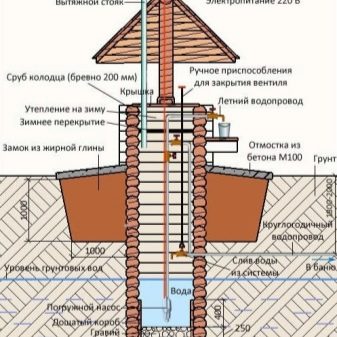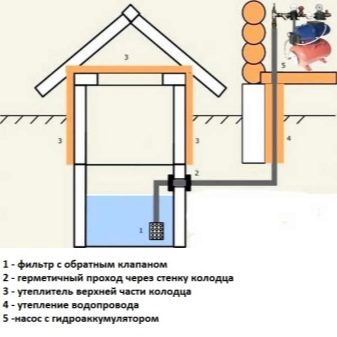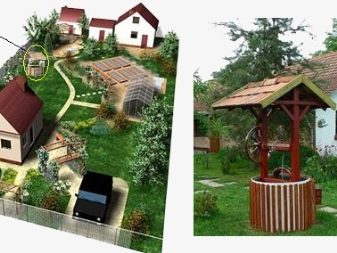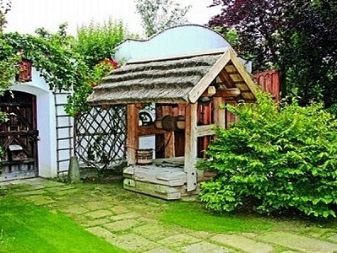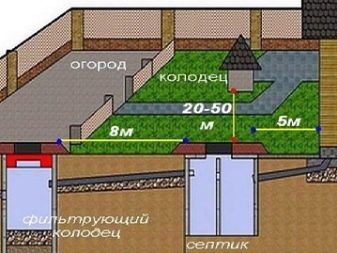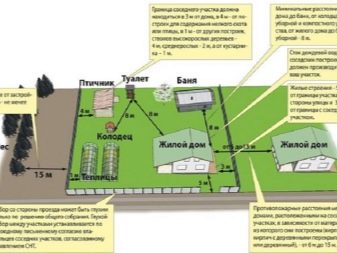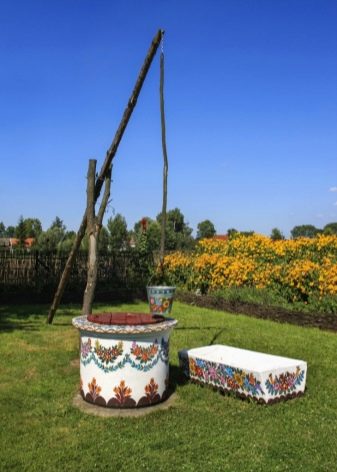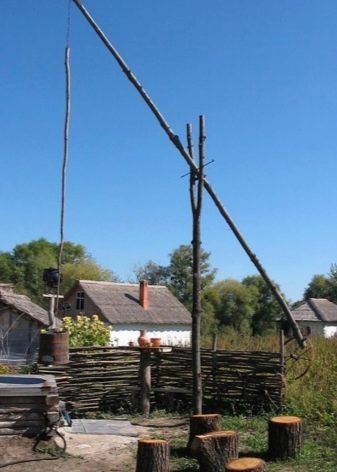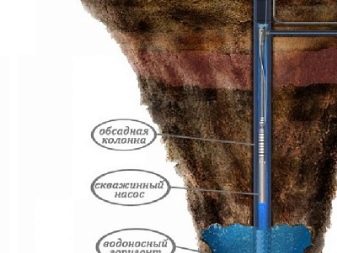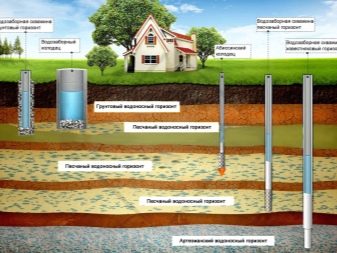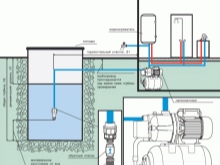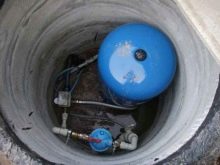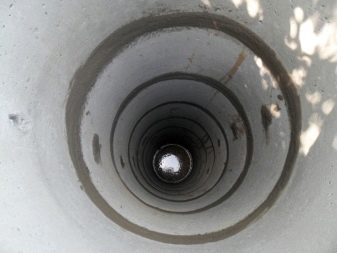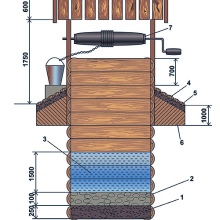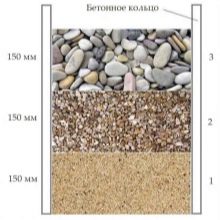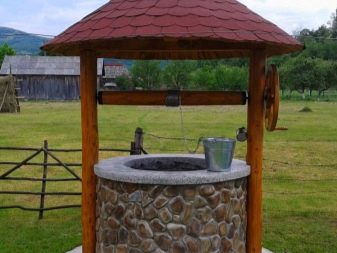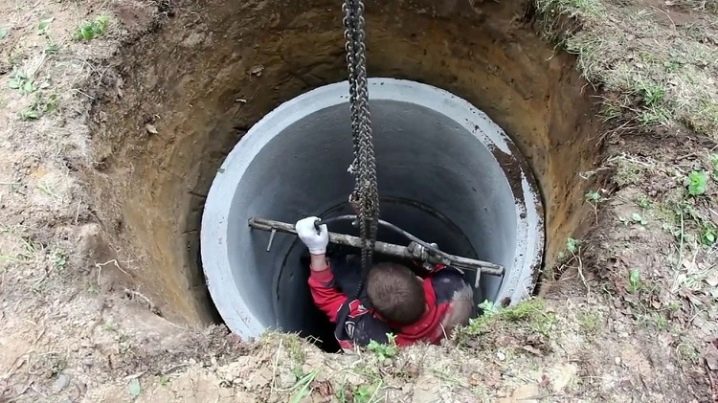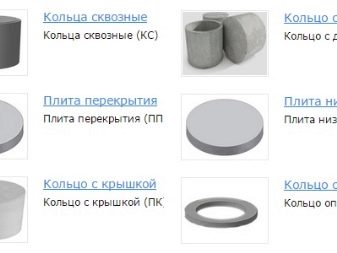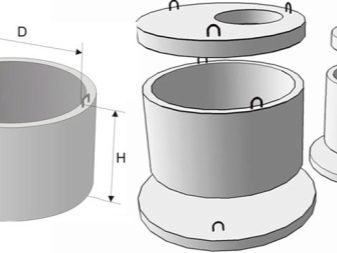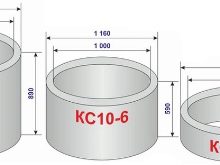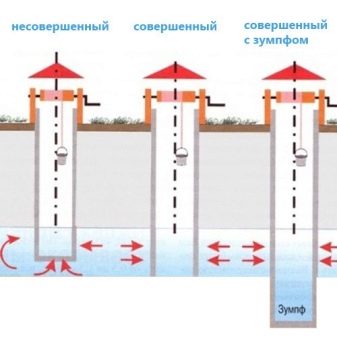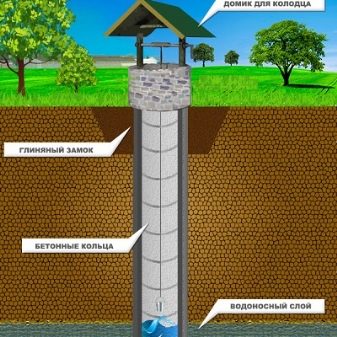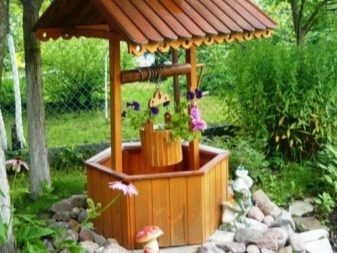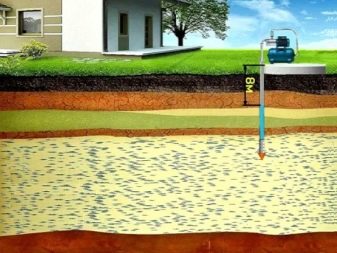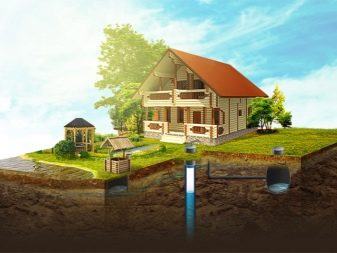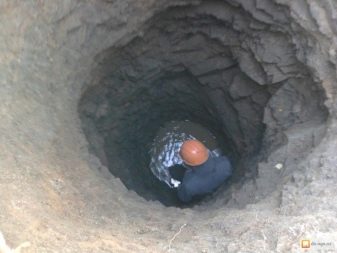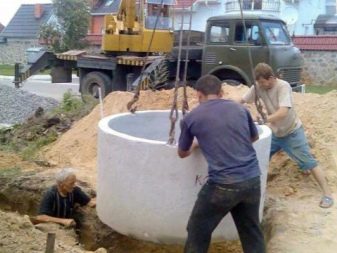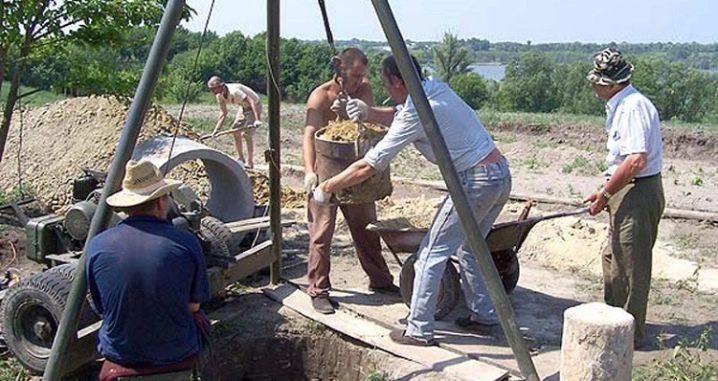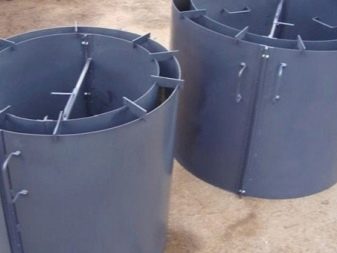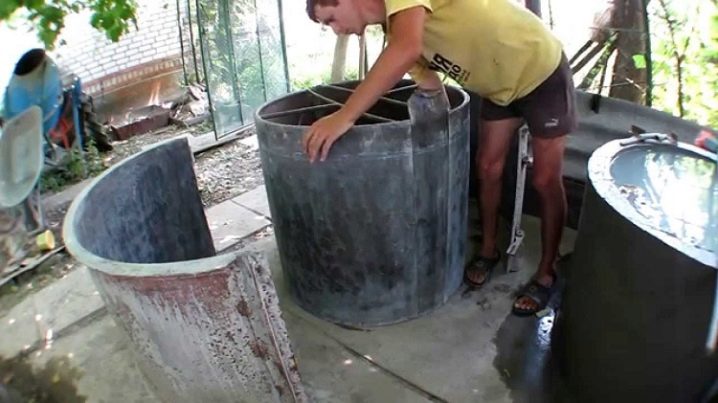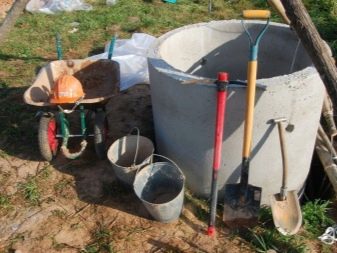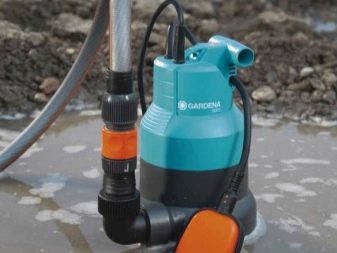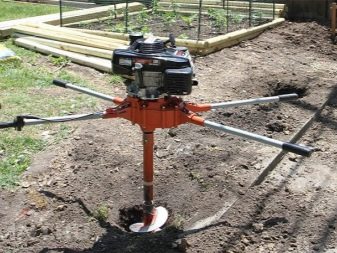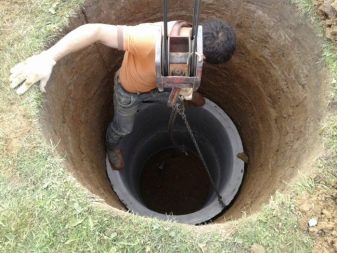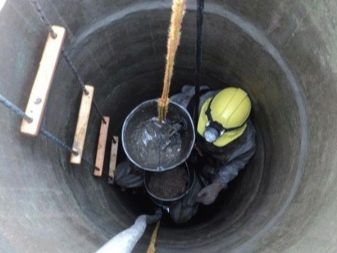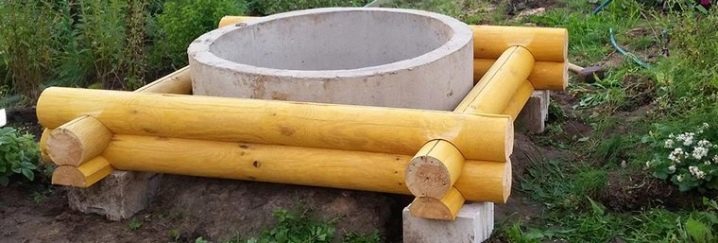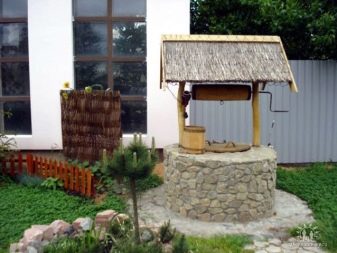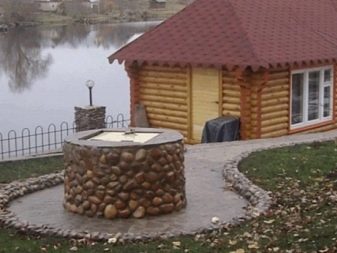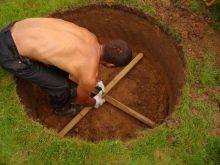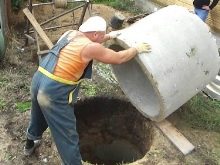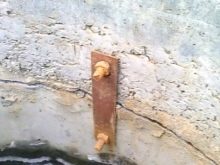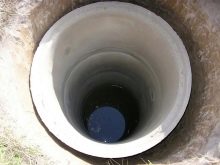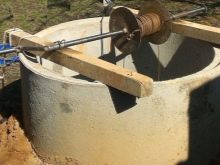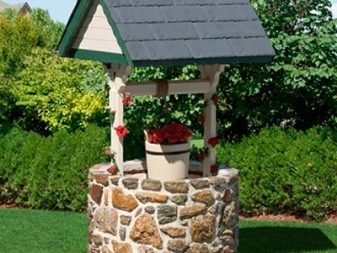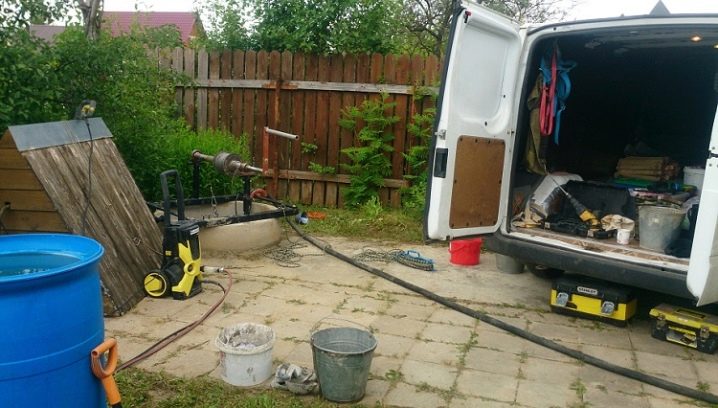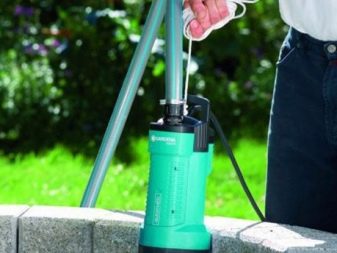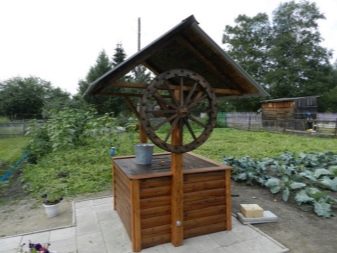How to make a well with your own hands?

The source of water in the garden is needed. It is desirable that its operation does not depend on temperature fluctuations, season and other factors, such as the availability of electricity. That is the source of the well. It is possible to lower the pump and pump water into the tanks for later use, eliminating the need to get water manually, but if you turn off the electricity without water, you will not be left. In addition, a big plus of your own well is that you can dig it up yourself, which means that its construction will be much cheaper than drilling a well.
Of course, the construction will take some time (the well will provide you with water much faster), but the result is worth it - durable and reliable water supply, independent of weather conditions and not related to the need to use electricity is an important component of comfortable living in a country private house.
Description and features
A well is a hydraulic structure consisting of a vertical recess (depth varies from 5 to 30 meters) with fortified walls and a topping (open or closed), equipped with a mechanism for lifting water. Water enters from the aquifer (“horizon”), accumulates at the bottom of the well shaft and rises upward along a vertical fortified recess. The water horizon can be different in size and "power" and located at a depth of 4 to 20 meters.
It is possible to raise water to the surface in various ways: using a bucket on a chain or rope, using a pole (“crane”) or a pump. It all depends on what method is traditionally used in the region and the wishes of the owners of the well.
We can not say about the features of the choice of the location of the well, because it is importantso that it not only turns out to be filled with drinking water of good quality upon completion, but also that it completely satisfies the need for water in the necessary volumes - for household needs, watering, bathing and showering.
If you are concerned about the adequacy of water in the well and its suitability for drinking, then you should follow certain rules and conditions for its construction:
- The well is located as far as possible from the cesspit and compost pits, landfills, gutters.
- You should not have a well very close to the house, especially close to the foundation.
- There should be no high water in the place chosen under the well. The arrangement of the well in a swampy area threatens with the entry of horsemen into it, polluting drinking water and constantly affecting the walls of the mine, destroying the structure.
- Do not place the well close to the banks of rivers and streams, water in such places contains manganese and iron in large quantities.
- The place where the marsh was once located is also not the best option for placing a well construction - the water in this area has a ferrous taste.
- To search for water at elevations or close to wells is practically useless.
- Pay attention to the types of plants, they will tell you whether to dig a well in this place. People signs suggesting the presence of groundwater tell us that willows, birch, lingonberry, clover and sage will grow in these places. But there, where the pine tree or acacia grows well, you should not look for water.
- Small natural depressions and depressions of relief are a kind of indicator of the presence of water under the ground, as well as fog standing above certain parts of the earth in the early morning.
- If you have already dug into the depths of twenty meters, and yet the aquifer has not been reached, then, most likely, the water horizon lies very deep and it will be easier to drill a well.
Species
Even before the middle of the last century in Russia, the well was usually a wooden blockhouse with a collar or a crane installed above it. Today, almost all wooden structures are almost never found, because reinforced concrete well rings have gradually gained immense popularity throughout the country. The difference in the level and volume of groundwater causes the presence of different variations of well structures.
Today you can find the following types of wells:
- "Crane" - this well is built where groundwater lies close - no deeper than 10 meters. The mechanism is a lever with a counterweight on one shoulder and a bucket for drawing water on the other. Thanks to this design it is possible not to expend much effort, as, for example, when the gate is rotating. There are many types and forms of “crane”: sometimes the body itself falls and rises, sometimes - only the front part of the structure - the “neck”.
- "Abyssinian" the well is an artesian well, which implies the installation of a pipe with a tip into the aquifer using a drill. Sieve tip allows filtration of groundwater. The Abyssinian well is supplied with a surface pump, since the tube of the Abyssinian well is too narrow for a submersible pump.
- "Archimedes screw" - well, common in the southern regions. The screw, thanks to which water tanks rise to the surface, turns the “donkey”, and the water is sent to the water conduit.
- "Shaduf" - also an “eastern” version of the well, equipped with a lever system similar to the Russian “crane”. "Shaduf" was known in the days of ancient Egypt.
- Traditional "Russian" well. His device is familiar to almost everyone - a vertical shaft with walls or walls reinforced with wood or concrete, covered or open, equipped with a collar, a drum and a handle. The bucket is attached to the drum with a rope or chain. Sometimes a band brake is used to eliminate excessive drum spin speed.
- "Well". The well with a submersible pump in the form of a well is especially popular lately, because suburban construction in our country is developing at a rapid pace. Such a well, made with the help of special equipment, will be ready for use within a few hours. With the seeming simplicity of the device, the design also has certain drawbacks - the high cost of drilling and dependence on the availability of electricity.
- Water well. It is an indispensable element of water supply through the water supply system. The construction of a water well involves the installation of various plumbing equipment in an underground tank made of concrete or plastic: valves, taps, devices for metering water flow, etc. arrangement is better to entrust the professionals.Thus, the working part of the well (the place where water will accumulate) should not exceed 1.5 meters.
There are requirements for the ratio of the diameter of the pipes and the distance of their location from the walls of the well.
Materials
In order to understand what materials you will need for the arrangement of the well, you need to be well aware of its elements and what they can be made of. All wells have a “trunk” - the longest and fortified part of the well, thanks to which drinking water will not mix with horse. In addition, the "trunk" will keep the walls of the mine from creeping and destruction, because it can block the flow of water from the aquifer.
The barrel of the well needs to be strengthened. Various materials are suitable for this: rectangular concrete slabs, concrete rings, concrete goods, wooden logs, stone or brick. In addition, the walls of the mine are sometimes made of solid concrete, but this method is suitable only for experienced builders. For self-construction it is recommended to use concrete rings - this method is more convenient and easier than all the others. Building a wooden or concrete well is primarily a financial issue.Reinforced concrete rings are more expensive, but much more durable.
The upper, above-ground part of the well, is called the “cap”. In addition to the decorative function, the tip is necessary to protect the well from dust, leaves and other debris. The cap is necessary in order to protect the well from winter freezing. It can be made of stone, brick, concrete, wood, or a combination of these materials.
Special attention should be paid to the water intake - the bottom of the well, its lowest part. It is thanks to the water intake that clean water from the aquifer falls into the well. If water appeared at the bottom of the well, then this is a sure sign that you are in an aquifer. Water should be pumped out and, deepening the bottom of the well by another 15 cm, install a filter from a layer of coarse sand (1-15 cm), (the very first, lower layer), a second layer of fine crushed stone (10-15 cm) and a third layer of large crushed stone ( 15-20 cm).
It happens that the bottom of the well is too “diluted”, muddy. In this case, a plank bottom (floor) with holes for water intake is installed on the bottom, and a filter is poured onto it.
It should be noted that the volume of water accumulated in the mine will depend on its volume. But the volume should not be confused with the concept of "flow rate" of the well, since it represents the amount of water that the well is capable of giving in a day. The greater the flow rate, the faster the well is filled. It is impossible to determine the flow rate in advance - the builders of the well will not increase this figure.
Such additional elements as the gate, the cover, the well chain can differ greatly from each other in different wells, but their main function is the same - to facilitate the owners of the process of extracting water.
Dimensions
Those who are going to build a well on their own, experts advise to opt for reinforced concrete rings. This ring is a rounded product with a diameter of 0.7 to 3 meters. The height of the ring can be different: the narrowest rings are only 10 cm high, the widest are 90 centimeters. The variety of sizes is due to the fact that ZhBT-rings are used for a variety of underground and above-ground structures: water systems, sewage systems, electrical communication and gas mines, etc.
All concrete rings have state standards - this is GOST 8020-90. There are requirements for the brand of cement (200 \ 500) and the requirements for compliance with the marking of concrete products.
So you can independently understand the intricacies of marking and determine the intended purpose of the product, we give the basic letter symbols:
- the well ring for the fundamental part of the well, "support", is marked with the letters "KO";
- ring for small standard wells, "wall" - KS;
- products for water and gas pipelines - “KVG”;
- rings for drainage systems and collector drains - “KFK”;
- rings for sewers and drains - "KLK".
In addition to the letter marking indicating the main use of the product, it will indicate the height and diameter of the product. For example, the combination of letters and numbers "KO-10-8" stands for a support ring with a diameter of 10 dm with a height of 80 centimeters. The most demanded ZhBT-product to strengthen well mines is marked KS-10-9, characterized by high quality at a low price.
In addition to the main types of rings, you can always buy additional:
- rings for retrofitting the length of the shaft, called "additional";
- rings to complement the solid design (products with holes, small height, etc.) - "auxiliary";
- “Floor slabs” and “bottom plates”, if necessary, to completely seal the well from above and below.
How to choose?
If you are a happy owner of a large plot and it has many fruit trees or even a pool, then a simple shaft well may not be enough to maintain it, since most of the wells have no more than 200 liters of liquid per hour.
A shallow well is always dependent on the season and precipitation, so in the spring it can overflow and create a real flood on the site, and on the contrary, it can dry out in the hot summer.
The shaft well will be ideal on a site where the aquifer is not very deep. In this case, the pit can be dug independently, and modern materials will ensure a long service life of the structure.
The owners of both wells and wells agree that well water is tastierHowever, it should be remembered that industrial enterprises located near your site, farms, fields treated with chemicals and fertilizers, can greatly spoil both taste and water quality.
The aquifer is located at a depth of 5 to 25 meters, so precipitation along with chemical compounds or unpleasant runoff can fall into it. Reviews of the owners of wells are unambiguous - you can not worry about the quality of artesian water as well as the quality of the well.
The advantages of the artesian well are primarily in the almost unlimited amount of water that can be extracted from it. Many owners of a private house and a well in the garden plots are forced to purchase an electric generator, since it will be impossible to get water in case of a sudden power outage.
Construction of a well will cost a lot less than a well, even if you later have to pump water from it, rather than manually. The average cost of one ring is about 2,000 rubles. Therefore, estimating the expected costs of building a well, first of all, estimate the depth of the well mines located close to your site. If you do not use the well all the time, it will be silted. It should be remembered that all groundwater is technical, so even in the country you should consider an additional purification system.
Hiring workers
If you do not plan to carry out work on the construction of the well yourself, then you can always hire a few specialists for this work or even a whole crew. But it is important to choose the workers correctly, so as not to lose time and avoid unnecessary costs.
Following these tips will help not to make the wrong choice:
- It is important to imagine what you want to get. Prepare in advance photos of wells that are suitable for you to show them to the masters.
- Find out in advance the cost of materials in your area and their approximate consumption.
- The cost of materials will be affected by the remoteness of the construction bases from the personal plot, its remoteness from the city, and the convenience of access to it.
After you not only represent the approximate cost of the work and materials, but also the future well itself, you can begin the search for specialists. If you can evaluate the work that was carried out by the team, it will be very good. If you don’t like the result, feel free to refuse the offer, because even if you’re satisfied with everything, it doesn’t mean that you will definitely like it.
Do not be tempted by the proposals of master-wagons, who "will dig a well, build a pool, and block the roof." The quality of work of such masters is usually average and below average, because there is no time left for serious mastering of professional skills.
Choose masters or a team that specializes in building wells.
Masters or a team must be mobile, so experienced builders have a car. We recommend to pay attention to the condition of the car, it also speaks about the attitude to work in general. By the way, all shipping costs are negotiated in advance.
Pay attention to the behavior of the master. The promise of the minimum terms and the phone breaking from the calls should put you on guard - there is a risk that the master will try to cheat by doing the work as quickly as possible, and maybe not finish it. An honest master will surely warn you that he is unfamiliar with some kind of work. Masters who exaggerate their talents and promise “everything at once” clearly deceive their employers.
Writing a written agreement is never redundant and is designed to reduce concerns about time and costs.
If a verbal agreement is concluded with the master, then we recommend that you pay attention to the following points:
- Ask the master phone his previous employers and ask him questions about the conflict, decency and honesty of the artist.
- Well located on the street, which means that the work will depend on weather conditions. If the deadlines for the work may change due to any factors, then these issues should be discussed in advance with the master or brigade.
- In the process of work, there may be overspending of material and other circumstances that increase costs (the well turned out to be deeper than previously thought, large stones met in the mine, etc.). These moments should also be discussed in advance.
- We recommend to agree with the masters on the breakdown of the work into stages and pay for each stage after its implementation. Agree on the approximate dates of each stage.
Independent production
It’s not difficult to buy ready-made rings for a well today, but if for some reason this cannot be done, then you can make them yourself, especially as the form is usually made from scrap materials, and the usual reinforcing mesh will be suitable for strengthening the structure. A solution of concrete is poured into the mold.
For the manufacture of rings you need a form - a composite metal or wood. It should be noted that many construction companies offer them for rent. The easiest way to do it yourself is to make a form from metal barrels or pipes of different diameters. It is more convenient to remove the inner cylinder if it consists of 4 or more parts, and for the outer cylinder 2 parts are sufficient.
So that the form is not sold out, when you pour concrete into it, its parts must be connected with fasteners, as which you can use anything - latches, door and window canopies, ears, and so on.
To make the form easier to remove from the frozen concrete, handles are welded to it (you can use handles from old doors) and line the surface with plastic wrap. The same distance between the outer and inner ring will provide wooden struts.
Well ring - a design that has considerable weight. The larger the diameter, the thicker the walls and the heavier the ring. Sometimes the standard ring height is reduced - this is necessary if the ring of normal size is no longer included in the well and it is necessary to use the “dobroe” ring. To the rings were not very heavy and it was possible to do without the construction of the well without special equipment, it is necessary to use a reinforcing mesh. In this case, even with a wall thickness of only 6-8 cm, it will be strong enough.
To prepare the concrete to fill the mold, you will need cement grade 400, sand (it is best to use quartz), crushed stone and water. If the rubble is contaminated with clay, you will need to wash it with water.In addition, experts recommend choosing granite rubble with a grain size of not more than 20 mm and cubic faces. Crushed stone with needle edges (plate) for the manufacture of concrete rings will not work.
When mixing concrete, all the ingredients are combined in a ratio by volume of 1: 2: 3 (cement \ sand \ gravel). The scheme is very simple: 1 bucket of cement + 2 buckets of sand + 3 buckets of gravel + 0.5 buckets of water. Particular attention should be paid to the amount of water, since the strength of the structure will depend on it. To find out the required amount of water, simply divide the mass (or volume) of cement in half. Mix the mixture most often with the help of a concrete mixer - they come in all different sizes, but you can also mix by hand.
Tools and accessories
On the construction of wells, many articles and entire monographs have been written, but to date, this standard is not standardized by any standards or official provisions. Therefore, you can use various tools - those that are convenient for you.
Experienced craftsmen say that in order to dig a well, three things are enough - a bucket with a rope, a small scrap and a shovel with a shortened "T" shaped handle.The main components are, of course, reinforced concrete rings, connecting metal brackets, gravel and crushed stone for the bottom filter, cement and sand for the connecting solution.
Of course, the above is the minimum set. The construction will be facilitated by such tools as a hand drill, a level, a wooden ladder and a rope ladder, a tripod and a winch for lifting earth and stones, buckets of different sizes. Spade need and bayonet, and shovels. For the transport of concrete rings does not interfere with a simple wooden cart.
During construction, water may accumulate at the bottom of the well, so you will need a simple submersible pump to remove it. He will be needed when reaching the water horizon. It is desirable to have in stock a number of boards (slab), if the walls of the well need to be strengthened in the process of digging. The construction of a well is not the easiest thing, besides representing a danger to the health and even the lives of builders.
To avoid any trouble in the process of work, you must follow simple rules:
- If you work inside the well shaft - wear a construction helmet! Above can fall and stones, and building materials.
- Chains and ropes should be inspected daily, since the ropes tend to fray, and the links of chains - to diverge.
- All the details of the mechanisms and dredging tanks are also checked for durability.
- In the mine well will be quite damp and very cool, so you should not spend in the mine the whole day.
- If there is such an opportunity, then it is best to replace the person working inside the mine every hour and a half.
Calculations
Too wide (large in diameter) well does not guarantee the presence of large amounts of water in it. The flow rate of the well is determined by the capabilities of the aquifer, and not by the size of the well’s shaft. Therefore, it is not necessary to increase the construction costs by constructing a wide shaft and purchasing large diameter rings. It is impossible to determine in advance the distance to the aquifer and the flow rate of the well - one can only roughly focus on the depth of the wells and the amount of water in them from the neighbors.
So, the standard diameter of the well can be from 0.8 to 1.5 meters. The depth of the standard mine can reach up to 30 meters. If the water lies deeper, then it is more rational to use a drilling rig.Also, drilling is more reasonable and easier to carry out when constructing a well in rocky or semi-rocky rocks.
The ground part of the well (tip) should rise 60-90 cm above the ground. At the same time, an earthen lock (trench around the well) about a meter deep and about 0.5 m wide is performed around the ground part. The lock can be reinforced from above with a paving made of concrete, brick or stone. The blind area is not less than 1 meter, it should be constructed with a slight bias from the walls of the well.
When you have already decided on the type of construction, you can proceed to construction, after completing calculations to determine how much of the well is suitable for your family and your backyard. The amount of water consumed can be calculated using numerous online calculators or using the formula V = S * h. To determine the area (S), it is necessary in the formula S = R2, familiar from school, where = 3.14, to substitute the available data (radius).
If you only need drinking water, then a family of 4 people will have enough volume from 500 to 1000 liters of water. But to have enough water not only for drinking, but also for household needs, we count the volume of the well in three times the size: V = R2 x h x 3.
How to dig?
First of all, you need to decide on what kind of water you need - technical or drinking. From this will depend on the design and depth of the well. The main difference between industrial and drinking water is the presence of various mineral impurities. Such water may even be cloudy and smell. Drinking water should not have any taste, color or smell. When digging wells, an unclean upper layer is located — the layer closest to the earth’s surface; groundwater, which can be at different depths and under pressure — is what well builders are looking for; artesian water is the deepest layer that will require drilling .
To get technical water with your own hands, special skills or costs will not be required. It is enough to dig a shallow well, revealing a layer with a water-pipe or a little deep into it. In such a well, there will be noticeable drops in the water level, so in winter and summer the moisture will be much less in the well than in spring and autumn. In order for your well not to dry out during a hot period, you need to “pass” the layer of water pipe, going deep into the groundwater.
When deepening can come across as waterproof soil layers, and waterproof. Digging a similar well is a long matter. Efforts and funds for its construction will take much more than to build a structure with a top layer. Water, even from a very deep well, must be tested at a sanitary epidemiological station. There are many examples when even water from a well had to be subjected to additional purification.
Also remember that the distance between the foundation of the house and the shaft of the well must be more than 5 meters. Groundwater can flush out the soil, which can destroy the integrity of the foundation if the earth drains.
Work order
The algorithm for the construction of the well is as follows:
- First you need to make a markup in the place where the well will be located. Draw a future diameter on the ground - it should be 10 centimeters larger than the diameter of the rings.
- Next, we dig a hole about centimeters less by 10 centimeters than the first ring. We install the ring in the pit, while there should not be even the slightest distortions. The distortion of even one ring can affect the quality of the well as a whole.
- After the first ring is installed (10-12 cm visible on the surface), you can begin the installation of the second.A few years ago, the contiguous sides of the rings were absolutely flat, but today there are convenient to install rings with groove-comb joints and rings with locks. Such rings are much easier to install - they do not move with further deepening and provide a more tight fit of the seams. If you could not buy rings with curly joints, then ordinary rings will have to be connected with staples.
- The next stage is the deepening of the pit (no more than 80 cm). If the ground is soft, then the pit begins to deepen in the center, and then dig in a circle. If the ground is solid, then you need to start directly from the ground under the ring itself. As a result, the first and second rings are immersed in the ground under their own weight.
- An important point - sealing the seams. This is done immediately, as soon as the rings fall under the ground, timely sealing will ensure the protection of the well (and its builders) from the inside from the groundwater. Most often, the sealing of seams is carried out with the help of tarred rope and cement mortar.
- The next stage is the extension of the rings and the further digging of the mine. This process lasts until you reach the water horizon, which you will immediately determine by the rapid accumulation of water at the bottom of the well.
- The bottom of the well is cleaned of water and sludge for several days, so that water veins are visible at the bottom of the mine.
- Next, the well must be left for some time (about a day), after which the water is pumped out and the sand is removed for laying the filter. We have already written about the filter before, but we recall that this is a layer of coarse sand, a layer of medium gravel and a layer of coarse gravel or rubble.
- The water level in your well may be different. The optimum is about 1.5 meters.
- Do not forget about the mandatory filling of the space between the rings and the ground with gravel and sand, as well as the mandatory filling of the space around the surface around the well with clay. Waterproofing "clay castle" will not allow penetration into the well of rain and melt water, as long as it is at least 0.5 meters wide.
- After completion of the work in the mine well, you can build a beautiful top in the form of a house or restrict yourself to a simple box with a roof. In any case, the well must be closed with a lid on the basis of safety and hygiene requirements.
What time of year is better to build?
Regarding the choice of time for the arrangement of the well, even among experts, opinions differ.Many people prefer winter time, because it is in winter that the groundwater does not interfere so much with its arrangement. In addition, it is in winter that the aquifer is lower than in other seasons. True, digging frozen ground is not very easy. Springtime is not too favorable for construction - thawed snow many times increases the amount of water and groundwater.
It is also not recommended to dig a well during a period of prolonged rains. (even if you started working in dry weather, but then there were constant showers, it is better to stop construction for a while). The construction time of a well can vary greatly for different regions and depends on how the level of groundwater varies throughout the year. You need to choose the season when the soil is minimally saturated with moisture. In the Central and North-West region of Russia, the driest period is summer and early autumn, so it is best to plan the construction of the well at this time.
Care
It is necessary to clean the well twice a year, for which water is completely pumped out of it, and silt, dirt and sand are removed from the bottom. If the water from the well has an unpleasant smell, then the well should be disinfected.To do this, as well as in the cleaning process, it is necessary to remove the dirt, after pumping out the water, and then treat the walls of the well with chlorine solution. Next, we wait for filling the well and add chlorine in the amount of 150 mg per liter of water.
We leave water with chlorine for 2-3 hours, after which we pump it out. We perform the procedure of pumping water until the smell of chlorine completely disappears. In case of close location of the aquifers and severe winter frosts, the well must be warmed. Otherwise, the water may just freeze. To protect against freezing over the well built "house" with insulation.
For insulation any suitable material. If a water supply pipe is connected to the well, then it should be in the mine below the level of potential freezing.
Useful tips
If there is not enough water in the well, then this can be corrected in several ways:
- try to deepen the mine to the next aquifer;
- to dig a ditch a little deeper than a water bed (this technology is called “sump”);
- the lower level of the mine can be made in the form of a “tent” or “tent” - the expanding walls will allow to increase the volume of the fence with a small flow.
A place for digging should be chosen carefully, because further construction on the site will depend on it. So, a bathhouse, toilet, compost pit and similar structures will need to be constructed as far as possible from the well shaft, since no drains should enter it. Air mine well during construction! This can be done with a fan or a conventional vacuum cleaner. In addition, when digging you can expect an unpleasant surprise in the form of the so-called "gas pocket", which is able to poison the air in the mine.
The best way to check the mine for the presence of gas - burning torch. Exactly burning speaks of clean air suitable for breathing. Quickly extinguished - a high level of gas pollution.
If you plan to connect the well with water supply, then the hole for the pipe will need to be made in the second ring.
How to actually determine the place and depth of the future well, at what time of year it is better to dig, what is a well knife, why rings with a lock are not the way out, and why it is so important to seal the seams after installing the rings, an expert in the video below will tell.

